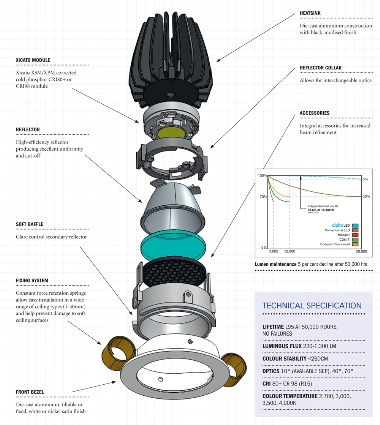Amanda Allen joined Projection Lighting sales director Martin Barker at Mark Ridler's Clerkenwell office to put the firm's 70 Series Imp range, a family of downlights designed as halogen replacements, through its paces
Projection Lighting's 70 Series Imp range is a family of discrete, recessed downlights designed to appeal to the 'creative instincts' of designers. According to the company, the range was heavily influenced by industry feedback and is designed to offer designers the efficiencies of LED and the design characteristics of halogen. That statement alone was enough to pique the interest of BDP's Mark Ridler when Projection Lighting's regional sales director, Martin Barker, visited his office recently.
"The idea for Imp was first conceived four years ago and the series was designed as a halogen replacement," explains Barker. "The impression we got from the market was that designers wanted a certain look and they weren't prepared to move away from that for LED. The message was 'flexibility and creativity' and what we thought was going to be a simple downlight has expanded into many different applications. People want to create all the effects they could achieve with halogen and that's what we have tried to do with this series."
Aid to creativity
With that in mind the range comes with multiple accessory options, including soft optics and different beam angles, all within the same family of products. "With an 80mm diameter and single point light source the fitting looks similar to a halogen and affords the designer the benefits of good light distribution, excellent colour consistency and high CRI options," says Barker. "At 1,300 lm, this is doing the job of a single 26W CFL or greater, or of a 20W metal halide – but from a very small luminaire."
But the real proof of the pudding is in the eating and when Barker switches the fitting on and aims it at a white wall, Ridler is pleasantly surprised.
"Normally what happens is that you get a sharply defined beam edge, which immediately goes down to zero, or you end up with something that's really soft with no real definition. MR16s gave us soft optics that also had a beam shape that faded really softly, allowing you to blend those lights together. From what I'm seeing of this range, it's got that similar beam edge quality."

So far so good, but what else does the luminaire have to recommend it? Barker says that it fulfils a desire expressed by the industry to see the fitting's light source situated further away from the bezel.
"We achieved this by producing a built-in, factory-fitted baffle," says Barker. "That effectively moves the position of the reflector back by about 8mm and gives the dark light pin-hole effect. Also, because the light source is further back, glare is minimised."
The 70 Series uses the Xicato XSM/XPM modules, which, according to Projection, has enabled them to offer specifiers a longer guarantee. "We believe the Xicato system is the best. They have now supplied data to prove the performance of the modules, which in turn enables us to guarantee to the customer that there will be no noticeable colour shift and a maximum of 5 per cent lumen loss across the installation after five years.
We wouldn't have been able to do that unless we were absolutely confident about the light source," says Barker.
This is a major plus for Ridler: "Normally you are designing for a maintained illuminance, which means that a lot of power is wasted. It's not the lumens per watt that are going to save you the most money; it's the lumen maintenance, because you're only going to overdesign from day one by plus 5 per cent, rather than by plus 30 per cent. Those energy savings are massive."
Another plus point for Ridler is the fitting's neat, installation-friendly design. "Quite often lighting specifiers spec a product and then the contractor doesn't want to use it and your spec gets busted. A fitting designed with installation in mind is always going to meet less resistance," says Ridler.
Barker says that contractor feedback was also carefully considered during the evolution of the product. For additional flexibility in applications, it is possible to retrofit all the accessories and change the reflector.
"It's great to be able to pop the fitting out and make those changes on site, particularly for projects like exhibition halls or gallery environments," asks Mark. "But would that not require a secondary ceiling reel for it to work?"
Barker responds: "No, this fitting can actually be pulled down using the side springs and won't damage the ceiling. You can swap accessories without having to physically take it out of the ceiling. Using coil springs, it's designed for easy installation in a wide range of ceilings and helps prevent damage to any soft ceiling surfaces."
The 70 Series Imp range starts from £62, including a non-dimmable driver.





